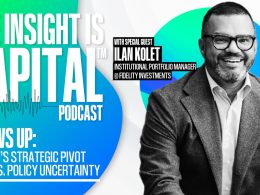Looking for Growth in the Right Places
by Equity Research, AllianceBernstein
When the market is fixated on short-term macroeconomic trends, investors should think differently. Look for companies and industries that benefit from distinctive long-term growth trends and that aren’t held hostage by a country’s macroeconomic fortunes.
Economic growth trends are always in the headlines. In recent years, as the US economic recovery has continued at a moderate pace, persistent concerns that a slowdown or recession is imminent have often grabbed investors’ attention and triggered market anxiety. But for active managers, looking at the latest macroeconomic indicators isn’t the best way to search for stocks with sustainable growth potential.
Outpacing the Economy
In fact, many industries are forecast to grow at much faster rates than the US economy in the coming years, no matter what the pace of gross domestic product will be (Display). Searching for companies that can benefit from secular growth trends is one of several ways that active investors can capture excess returns over long time horizons.

In the auto industry, demand is steadily rising for cutting-edge safety systems. Revenue from advanced driver-assistance systems is poised to rise rapidly (Display below, left), as the installed base is projected to increase from 3% of vehicles today to 30% in 2020—including virtually all new cars built after 2018. This trend is being fueled by consumer preferences, regulatory changes and insurance incentives. Growth in the auto industry tends to be cyclical, as sales rise and fall with the ebb and flow of the economy. However, as these systems become standard features on more new car models, we expect their growth to increase at a much steadier pace.

Digital Advertising Powers Ahead
Digital advertising is another area that is powering ahead (Display above, right). Major US consumer companies are continuing to shift spending toward digital advertising because the returns on their investment have eclipsed returns from traditional advertising during the last five years, even as economic growth has been lackluster.
Big Data is also a great source of secular growth. The amount of data in the world is growing exponentially, thanks to social media, Netflix, YouTube and the Internet of Things. All of that information must be stored, transported, analyzed and protected, which creates tremen¬dous growth opportunities that are likely to persist through changing economic conditions.
From Healthcare to Finance
Technology isn’t the only catalyst for durable secular growth. Take the healthcare sector, for example. People suffering from an illness don’t stop buying medications in an economic downturn. The aging US population is increasing the demand for drugs. And the Affordable Care Act has triggered a seismic shift in patient numbers and spending patterns that isn’t going to be dented by the direction or magnitude of economic growth.
Financial firms are often seen as vulnerable to economic momentum. Yet within the sector, credit card companies are benefiting from a long-term shift from cash and checks to electronic forms of payment. As a result, underlying transactions for some companies have been growing at around 10% for some time—approximately two to three times faster than underlying consumer spending. In an economic slowdown, that growth might slip a bit, but it should still be robust compared to that of other companies, because the payment-shift trend is continuing.
In contrast, earnings in the retail and manufacturing sectors are more directly tied to GDP growth and interest-rate trends. And of course, most energy companies are vulnerable to downturns, especially when an oil-price slump is at the heart of the problem. That doesn’t mean you should avoid all cyclical companies. But attractive equity opportunities in sectors like these should be approached with caution, given the uncertainty surrounding economic growth.
Seven years into a bull market, with the US economy growing modestly, not all boats will rise at the same pace. In this environment, being selective is essential to identifying stocks that can benefit from growth anomalies—and rise above formidable challenges—to deliver long-term returns.
The views expressed herein do not constitute research, investment advice or trade recommendations and do not necessarily represent the views of all AB portfolio-management teams.
Chief Investment Officer—Global Growth and Thematic

Daniel C. Roarty was appointed Chief Investment Officer of AllianceBernstein’s Global Growth and Thematic team in 2013. He joined the firm in May 2011 and was named sector head for the technology sector on the Global/International Research Growth team on July 1, 2011, and team leader for that team in early 2012. Roarty previously spent nine years at Nuveen Investments, where he co-managed a large-cap growth strategy and a multi-cap growth strategy. His research experience includes coverage of technology, industrials and financial stocks at Morgan Stanley and Goldman Sachs. Roarty holds a BS in finance from Fairfield University and an MBA from the Wharton School at the University of Pennsylvania. He is a CFA charterholder. Location: New York
Chief Investment Officer—Concentrated US Growth

James T. Tierney, Jr. is Chief Investment Officer of Concentrated US Growth. Prior to joining AllianceBernstein in December 2013, he was CIO at W.P. Stewart & Co. Tierney began his career in 1988 in equity research at J.P. Morgan Investment Management, where he analyzed entertainment, healthcare and finance companies. He left J.P. Morgan in 1990 to pursue an MBA and returned in 1992 as a senior analyst covering energy, transportation, media and entertainment. Tierney joined W.P. Stewart in 2000. He holds a BS in finance from Providence College and an MBA from Columbia Business School at Columbia University. Location: New York
Related Posts
Copyright © AllianceBernstein














